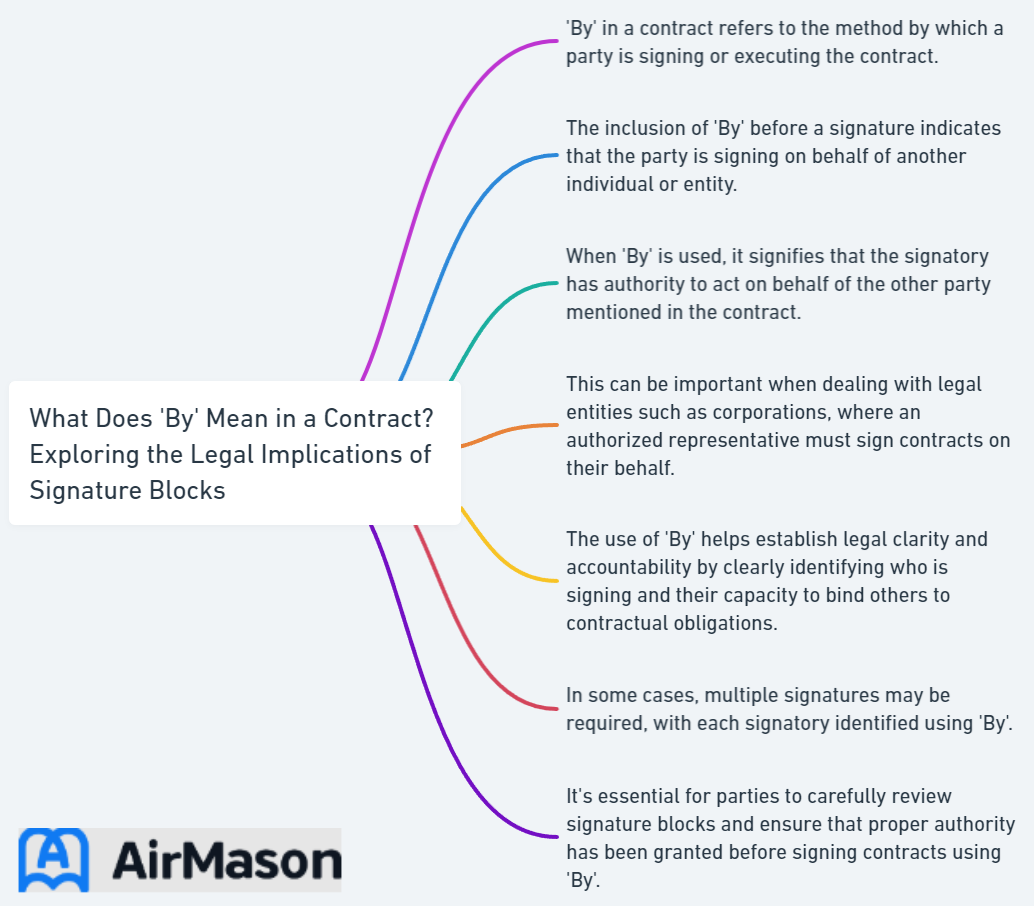
Understanding the meaning and implications of the signature block in contracts is crucial for anyone involved in the negotiation, drafting, or signing of legal agreements. This seemingly simple section of a contract carries significant weight and can directly impact the enforceability of an agreement. In this blog post, we delve into the complexities of the signature block, providing a comprehensive overview of its components, the legal implications of representation, and the essential elements of legally enforceable contracts. We also discuss common issues with signature blocks and provide tips on how to avoid potential legal problems.
The journey to mastering the intricacies of contract signature lines begins with decoding their components and understanding the role of crucial terms such as “what does by mean in a contract.” We then explore the importance of legal entity representation and the authority to sign contracts on behalf of businesses. Finally, we examine the building blocks of legally enforceable contracts, including offer and acceptance, consideration, and performance, and discuss common issues with signature blocks and ways to prevent them.
Key Takeaways
- Decoding the contract signature line is essential to identify signatories and ensure legal enforceability.
- The use of ‘By’ in a signature block guarantees accurate representation and authority for signing parties.
- Companies must properly authorize contracts by affirming signatory authority, selecting the right person with appropriate scope of power, drafting authorization letters if necessary, and monitoring the process to avoid potential disputes or validity issues.
Contracts Definition
When exploring the legal landscape, it’s crucial to grasp the contracts definition. In essence, contracts define the binding agreements between parties, outlining the rights, responsibilities, and terms of engagement. These legally enforceable documents serve as the backbone of various transactions, be it in business, real estate, or everyday interactions. Understanding contracts’ definition is paramount for navigating a myriad of scenarios, ensuring clarity and preventing misunderstandings. From the explicit terms to the implicit nuances, a comprehensive comprehension of contracts definition is pivotal in fostering fair and secure dealings in both personal and professional realms.
Decoding the Contract Signature Line
At first glance, a contract’s signature line may appear straightforward. However, it carries great significance in the realm of contract law. The signature line generally comprises the following components:
- Company name
- Signatory’s name
- Title
- Date
The term ‘By’ points to the individual signing on the company’s behalf. Recognizing these components is pivotal because they offer crucial insights into the parties’ legal obligations and help affirm the contract’s enforceability.
The term ‘By’ on the signature line holds considerable weight as it identifies the signatory and signifies that the individual is signing the agreement on the company’s behalf. This procedure confirms adequate representation and authority for the business entity involved in the agreement. Correct identification of signatories is necessary to evade disagreements and secure the contract’s legality.

The Role of ‘By’ in Signature Blocks
The term ‘By’ in a signature block plays a pivotal role in ensuring proper representation and authority for the contracting party. It signifies the individual signing the contract on behalf of the company, thereby establishing the legal authority and responsibility of the entity in the contract. In essence, the use of ‘By’ clarifies that the person signing the contract is doing so on behalf of a legal entity, rather than in their personal capacity.
The inclusion of ‘By’ in the signature block is vital in guaranteeing accurate representation and avoiding potential legal issues. It highlights the signatory’s capacity to bind the company to the agreement and helps ensure that the contract is legally enforceable. Without proper representation through the use of ‘By,’ the validity of the agreement may be called into question, potentially leading to disputes and costly legal battles.
Importance of Properly Identifying Signatories
Properly identifying signatories in a contract is of paramount importance in order to circumvent disputes and guarantee the contract’s legality. The identification of signatories is essential for the validity of a contract, as the law requires that the individuals who have agreed to be bound by the contract are properly identified and have provided their consent to abide by its terms.
Failing to accurately identify signatories in a contract may result in disputes, breach of contract, contractual risk, and potential legal validity issues, which can affect the effective date of the agreement. To avoid such issues, it is crucial to provide the full name of the signatory, their title or position within the company, the date of signing, and the signature of the contracting party.
Ensuring that all parties involved in a contract have the necessary authority to sign is a critical step in establishing a legally enforceable legal agreement, as it is when the parties agree on the terms.
Notarized Contract
When navigating legal agreements, having a notarized contract is crucial for ensuring authenticity and legal validity. A notarized contract, often a formal written agreement, gains an extra layer of credibility through the involvement of a notary public. This professional verifies the identities of the signing parties, witnesses the signing, and confirms that all involved parties entered into the contract willingly and knowingly. The notarization process adds a level of assurance and can be particularly important in various legal transactions, such as real estate deals or business agreements. Understanding the significance of a notarized contract is essential for anyone seeking to establish a secure and legally binding arrangement.
Understanding Legal Entity Representation

When signing a contract on behalf of a business entity, it is essential to have the appropriate authority to do so, as unauthorized signatures can lead to legal issues. A legal entity, in the context of business agreements, refers to any business or organization with a recognized legal status, capable of entering into contracts, owning property, and being held responsible for its actions. Authorized signatories are individuals or entities granted permission to sign legally binding contracts on a company’s behalf, as agreed upon by the parties involved.
In budding businesses, the CEO often serves as the authorized signatory. However, the power to sign contracts on the company’s behalf may lie with managers or company members, as dictated in the operating agreement, or with other individuals appointed by the board of directors or other governing bodies of the business entity. Grasping and verifying the signatories’ authorization is necessary to assure seamless execution of contracts and sidestep possible legal predicaments.
Authority to Sign Contracts for Business Entities
The authority to sign contracts for business entities is typically granted through internal governance documents, such as the company’s bylaws, resolutions, and delegation of authority policies. These documents outline the regulations and rules that govern the operations of the business and its activities, including the designation of individuals or positions within the company with the capacity to enter into contractual agreements on behalf of the company.
Delegation of signatory authority is often determined by the board of directors or other governing bodies of the business entity, with the authorization process specifying the individuals or positions within the organization granted the power to sign official documents and contracts on behalf of the entity.
Ensuring that the person signing a contract on behalf of a business entity has the appropriate authority is crucial to avoid disputes and potential legal issues, as well as to guarantee the contract’s enforceability.
Ensuring Proper Authorization
To circumvent disputes and possible legal issues, one must validate that the person signing a contract on behalf of a company possesses the proper authorization. Legal documents necessary for verifying contract signing authorization could include the appointment or designation of authorized signatories and the authorization to sign on the company’s behalf.
Best practices for ensuring proper authorization when signing contracts include:
- Identifying the need for signing authority
- Selecting the right person with the appropriate authority
- Determining the scope of authority
- Drafting an authorization letter if necessary
- Monitoring the signing process to ensure compliance
By following these best practices in the contracting process, companies can minimize the risk of disputes and legal issues arising from improperly executed contracts.
Elements of Legally Enforceable Contracts

Legally enforceable contracts require specific elements, including offer and acceptance, consideration, and performance. These elements are the building blocks of a valid contract, and their presence is crucial to ensure the enforceability of the agreement. In this section, we delve into the intricacies of these elements and their significance in the realm of contract law.
Grasping the key elements of legally enforceable contracts is vital for anyone partaking in the negotiation, drafting, or signing of legal agreements. Omitting these elements from a contract could render the agreement unenforceable, causing disputes and potential legal issues. To sidestep such problems, a comprehensive understanding of the elements needed for a contract to be legally enforceable is crucial.
Offer and Acceptance
Offer and acceptance are fundamental components of any legally enforceable contract. An offer is a clear proposal from one party, while acceptance is an unequivocal agreement from the other party. The “mirror image” rule stipulates that for a valid acceptance of an offer, it must be in accordance with the exact terms of the offer. This rule ensures that both parties are on the same page regarding the terms of the agreement and helps create a binding contract.
However, the Uniform Commercial Code provides an exception to the “mirror image” rule, stating that an acceptance with conditional terms shall form part of the contract unless the additional provisions materially alter the offer. It is essential to be aware of these rules and exceptions when negotiating and drafting contracts to ensure that the agreement is legally enforceable and both parties understand their obligations.
Consideration and Performance
Consideration refers to the exchange of value between parties in a contract. This exchange can take many forms, such as:
- the provision of a service
- the transfer of land or property
- the exchange of goods
- the relinquishment of an existing benefit
Consideration is a crucial element of any legally enforceable contract, as it ensures that both parties have a stake in the agreement and are committed to fulfilling their obligations.
Performance, on the other hand, involves the fulfillment of contractual obligations by the parties involved. The successful performance of a contract discharges the party’s responsibility and ensures adherence to the terms of the agreement. Failure to perform one’s contractual obligations can lead to a breach of contract and potential legal consequences.
Comprehending the roles of consideration and performance in contracts is vital to ensure a legally enforceable agreement and avert disputes.
What Are Contract Documents
When diving into the realm of construction or business agreements, understanding “what are contract documents” becomes pivotal. These documents encompass a comprehensive set of papers that delineate the terms, conditions, and specifications of a contractual relationship. These crucial papers typically include the agreement itself, drawings, specifications, and any additional supporting documents necessary for the parties involved to comprehend their roles and obligations. Clear and concise contract documents serve as the foundation for a successful and legally sound collaboration, guiding stakeholders through the intricacies of the project or business arrangement. Paying meticulous attention to the details within these documents ensures that all parties are on the same page and helps mitigate potential disputes down the line.
Common Issues with Signature Blocks and How to Avoid Them

Common issues with signature blocks can lead to disputes and potential legal problems. Ambiguity in signature lines, for example, can create confusion and disagreements over the validity of the contract or whether the signatory had the necessary authority to bind the parties involved. Ensuring proper execution of contracts is also crucial, as failure to do so can result in fines or imprisonment, and can affect the enforceability of the agreement.
These common issues can be avoided by paying meticulous attention to detail and adhering to best practices. Accurate identification of signatories, using clear and unambiguous language, and sticking to specific requirements for the type of contract being signed are all crucial steps in forging a legally enforceable agreement and evading possible legal issues.
Ambiguity in Signature Lines
Ambiguity in signature lines can create confusion and disputes, as it may be unclear who is signing the contract and in what capacity. This uncertainty can result in different interpretations of the contract terms, leading to legal disputes and litigation. For example, ambiguity in signature lines on a negotiable instrument has caused disputes regarding the validity and enforceability of the contract due to the signature indicating uncertainty as to whether a principal or an agent or both were signing.
To circumvent ambiguity in signature lines, clearly identifying the signatory and their actual signature, along with their authority within the company signing, is crucial. Furnishing the signatory’s full name, their title or position within the company, and the signing date can help dispel confusion and confirm the contract’s legal enforceability.
Additionally, using clear and unambiguous language in the signature block and throughout the contract can help prevent misunderstandings and potential legal issues.
Ensuring Proper Execution of Contracts
Proper execution of contracts comprises several steps like affirming the signatory’s authority, using clear and unambiguous language, and adhering to specific requirements for the type of contract being signed. Failure to properly execute a contract can lead to fines or imprisonment, and can impact the agreement’s enforceability.
Best practices for ensuring proper execution of contracts include:
- Identifying the need for signing authority
- Selecting the right person with the appropriate authority
- Determining the scope of authority
- Drafting an authorization letter if necessary
- Monitoring the signing process to ensure compliance
By adhering to these best practices, companies can minimize the risk of disputes and legal issues arising from improperly executed contracts.
Summary
In conclusion, understanding the legal implications of signature blocks in contracts is crucial for anyone involved in negotiation, drafting, or signing legal agreements. This blog post has provided a comprehensive overview of the components of the signature block, the legal implications of representation, and the essential elements of legally enforceable contracts. We have also discussed common issues with signature blocks and provided tips on how to avoid potential legal problems.
By taking the time to understand the intricacies of the signature block and ensuring proper execution of contracts, parties can minimize the risk of disputes and legal issues. As with any legal matter, it is always advisable to consult with an attorney when drafting or signing contracts to ensure that all necessary elements are in place and that the agreement is legally enforceable.
Frequently Asked Questions
What is the by line for on a contract?
The By line found on a contract typically includes the signatory’s title or function, to emphasize that they are not signing in their personal capacity. Their name and title is then noted under the signature line.
What does by and name mean on a contract?
On a contract, the ‘By’ line specifies the name of the signatory and the ‘It’ line specifies their function or title. These details are entered below the signature line to indicate that the individual is not signing in their personal capacity.
What does its stand for on a contract?
When signing a contract, “Its” is often used to denote what position the signer holds in the company, confirming they are authorized to make binding agreements on behalf of the organization.
How can I ensure that a contract signatory has the proper authorization to sign on behalf of a company?
Verify the signatory’s authority through the company’s operating agreement or bylaws, request documentation or proof of authority, and follow best practices to ensure proper authorization for the contract signatory.
What are the key elements required for a contract to be legally enforceable?
For a contract to be legally enforceable, it must include an offer and acceptance, consideration, and performance.